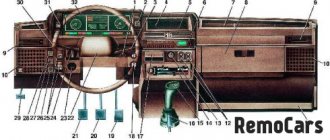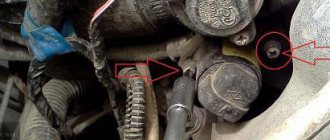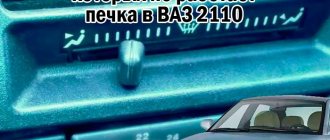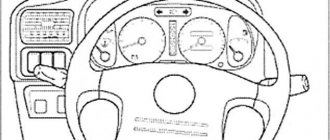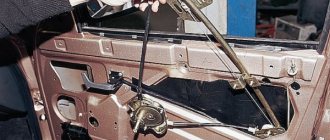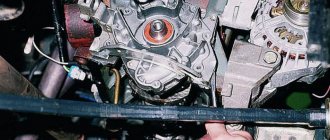The giving of turn signals is provided for in paragraphs 8.1 and 8.2 of the Rules of the Road. Turn on your turn signals not only before turning and changing lanes, but also before starting to move or before stopping at the edge of the roadway. Failure to comply with these rules can lead to an accident, therefore, a fine is provided for failure to turn on turn signals (Article 12.14 Part 1 of the Code of Administrative Offenses of the Russian Federation). The driver must monitor the technical condition of the turn signal system. For this, knowledge of its structure will be useful.
Troubleshooting if turns do not work, even if you do not have special knowledge.
Checking the serviceability of the turn relay.
And so let’s look at what to do if the turns of a front-wheel drive VAZ, except for the 2170 Priora, do not work. The operation and troubleshooting of which was discussed in the article “Prior Turning Relay”.
First, make sure that the measuring instruments and control lamps on the instrument panel are working. If they do not work, then check the fuse.
If the devices are working properly, turn on the hazard warning button and check that all the lamps in the direction indicators are blinking. This will allow you to divide the circuit into two parts and speed up troubleshooting.
If the alarm does not work when turned on, then it is necessary to check the serviceability of the turn and alarm relay and the presence of power at its terminal 49. The pin designation is marked on the bottom of the relay, next to the contact legs.
We remove the relay, which is marked in the form of a triangle on the top of the case, from the mounting block, and in the vacated socket, using a test paw, check for the presence of a plus on pin 49. We connect the test lamp to the ground or minus of the battery, and with the other end we touch pin 49, when If the hazard warning button is on, you do not need to turn on the ignition. Lack of power indicates a faulty fuse, alarm button or broken wires, contact tracks of the mounting block and poor contact in the connectors.
If there is a plus on the terminal, then connect terminals 49 and 49A with a copper wire. If the connecting wires and connectors are in good condition, all the direction indicator lamps should light up. This indicates that the turn signal and light signaling relay is faulty. If the lamps do not light up, but there is a plus on pin 49, then there may be a short circuit in the signal lamp circuit and the fuse has blown. A short circuit can also cause the relay to fail. In this case, check the serviceability of the fuse, and if it blows, eliminate the short circuit in the signal lamp circuit.
Checking the hazard warning button.
If the hazard warning lights are working, then the turn signal and hazard warning relays are working properly, but the fault may be in the hazard warning light button. First, check the plus, as described earlier at pin 49 of the relay, with the hazard warning button off and the ignition on.
If there is no plus, then you need to check the serviceability of the alarm button. To do this, you need to remove the button from the socket by prying it off with a thin screwdriver or remove the instrument panel visor. In the contact connector of the button, use a test lamp to check the presence of power at pin 2 (the numbering of pins on the button near the contacts) with the ignition on. If there is no power, repair the broken wire from the instrument panel to the button. If there is power, connect pin 2 to pin 5 in the button socket, with the ignition on, and turn on the direction indicators of either side. If the warning lights on this board light up, replace the faulty hazard warning button.
If the warning lights do not light up, then, without removing the jumper from the hazard warning button block, connect pins 49 and 49A with a copper wire in the relay socket, then check the power at pin 49A of the turn switch. To do this, remove the steering column cover and the connecting connector from the turn switch. You can also remove the switch itself to determine the pin numbers that are marked on its lower part next to the contact legs. This is not difficult to do by squeezing the latches on the sides of the switch and pulling it to the side. If the circuit from the relay to the switch is in good condition, the indicator lamp will start to light. If the control lamp does not light, then repair the break in the wire from the mounting block to the turn signal connector.
Tips for motorists
The VAZ-2110 turn indicators include six lamps located on the right and left sides of the car, two light signaling lamps on the instrument panel, a turn signal breaker relay and a fuse located in the mounting block, and controls all this under the steering switch.
The hazard warning lights work together with the direction indicators , and all wiring goes through the plug block of the hazard warning light button. Therefore, malfunctions that occur on this button also lead to failures in the direction indicators.
The most common malfunction of turn signals on a VAZ 2110 is the burnout of one of the lamps, which should have worked after it was turned on. A warning lamp will notify you of this. Its blinking frequency will increase exactly twice, which will be clearly visible to the driver who glances at the instrument panel. When replacing a burnt-out lamp, pay attention to its power; you need to replace it with exactly the same one, otherwise the light alarm will not work normally.
If the turn signals do not turn on on either the right or left side of the car. Then you will have to open the mounting block and check fuse F16. If this fuse is intact, pay attention to the relay breaker K3, it may have failed. You can check it as follows. You need to open the relay cover and, with the ignition on, bridge two contacts located perpendicular to each other using a piece of wire. If the turn signal lamps start to light without blinking, then this relay will have to be replaced, as it is faulty. But if the lamps do not light, then you will need to check the wires and plug blocks for lack of contact.
When turning on the turns, the fuse blows.
Another malfunction of the direction indicators is the fuse blowing when the indicators of one of the sides are turned on. To quickly identify a malfunction, turn on the hazard warning lights. The signal lamp in a circuit that has a short circuit will not light up or will burn at full intensity. A sign of a short circuit in the signal lamp circuit can be a buzzing sound from the turn signal relay when the indicators are turned on. To facilitate troubleshooting when the VAZ direction indicators do not work, use the diagrams below.
Reasons for failure of turn signals and emergency lights
As you know, the circuit of direction indicators and hazard warning lights is tied, since both functions are performed by the same headlights. If for some reason the hazard lights are working, but the turn signals are not, or neither the turns nor the warning lights are on, this can lead to an emergency situation on the road.
For what reasons did these elements stop working:
- Fuse failure is one of the most common problems. If the car is additionally equipped with a relay that is responsible for the operation of these optical elements, then the problem may lie there. Depending on the car model, the relay may be located separately from the main fuse block; use the diagram to find the failed part.
- Short circuit in the system. Because of this, when turning on the turning lights, the emergency lights turn on or the optics do not respond to the driver’s commands at all. To diagnose the problem, you will need a tester, as well as the skills of an electrician.
- Failure of the lighting source. In other words, the light bulb has burned out.
- Open circuit. This problem is relevant for many car owners of older cars. If the wires are laid in a place where there are moving elements, then over time it will fray and lose its insulation, which will generally lead to damage to the electrical circuit.
- Failure of a button or steering column switch. In this case, it is necessary to carry out more thorough diagnostics of the switch, as well as the connection button.
Features of the scheme
The electrical circuit of the VAZ-2110 turn signals includes:
- lantern bulbs, six in total;
- two indicators installed on the dashboard;
- emergency button;
- Understeering's shifter;
- power supply;
- circuit breakers;
- interrupt relay.
The last two elements, responsible for the turn signal, are located nearby - in the mounting block. This unit is installed in the cabin, to the left of the steering wheel. It is closed by a decorative flap, to access which you just need to press the latch located above.
The emergency lights operate in parallel with the turn signals. Their wires are connected by the terminals of one block. It is from this that the veins go to the button that switches the general lighting devices to a mode signaling a breakdown that has occurred on the road. You need to know about this feature of the circuit when starting to search for the reasons for the failure of the lights. The problem is that a faulty VAZ-2110 emergency warning button often causes the turn signals to fail.
Troubleshooting if turns do not work, even if you do not have special knowledge
Checking the serviceability of the turn relay
And so let’s look at what to do if the turns of a front-wheel drive VAZ, except for the 2170 Priora, do not work. The operation and troubleshooting of which was discussed in the article “Prior Turning Relay”.
First, make sure that the measuring instruments and control lamps on the instrument panel are working. If they do not work, then check the fuse.
If the devices are working properly, turn on the hazard warning button and check that all the lamps in the direction indicators are blinking. This will allow you to divide the circuit into two parts and speed up troubleshooting.
If the alarm does not work when turned on, then it is necessary to check the serviceability of the turn and alarm relay and the presence of power at its terminal 49. The pin designation is marked on the bottom of the relay, next to the contact legs.
We remove the relay, which is marked in the form of a triangle on the top of the case, from the mounting block, and in the vacated socket, using a test paw, check for the presence of a plus on pin 49. We connect the test lamp to the ground or minus of the battery, and with the other end we touch pin 49, when If the hazard warning button is on, you do not need to turn on the ignition. Lack of power indicates a faulty fuse, alarm button or broken wires, contact tracks of the mounting block and poor contact in the connectors.
If there is a plus on the terminal, then connect terminals 49 and 49A with a copper wire. If the connecting wires and connectors are in good condition, all the direction indicator lamps should light up. This indicates that the turn signal and light signaling relay is faulty. If the lamps do not light up, but there is a plus on pin 49, then there may be a short circuit in the signal lamp circuit and the fuse has blown. A short circuit can also cause the relay to fail. In this case, check the serviceability of the fuse, and if it blows, eliminate the short circuit in the signal lamp circuit.
Checking the hazard warning button
If the hazard warning lights are working, then the turn signal and hazard warning relays are working properly, but the fault may be in the hazard warning light button. First, check the plus, as described earlier at pin 49 of the relay, with the hazard warning button off and the ignition on.
If there is no plus, then you need to check the serviceability of the alarm button. To do this, you need to remove the button from the socket by prying it off with a thin screwdriver or remove the instrument panel visor. In the contact connector of the button, use a test lamp to check the presence of power at pin 2 (the numbering of pins on the button near the contacts) with the ignition on. If there is no power, repair the broken wire from the instrument panel to the button. If there is power, connect pin 2 to pin 5 in the button socket, with the ignition on, and turn on the direction indicators of either side. If the warning lights on this board light up, replace the faulty hazard warning button.
If the warning lights do not light up, then, without removing the jumper from the hazard warning button block, connect pins 49 and 49A with a copper wire in the relay socket, then check the power at pin 49A of the turn switch. To do this, remove the steering column cover and the connecting connector from the turn switch. You can also remove the switch itself to determine the pin numbers that are marked on its lower part next to the contact legs. This is not difficult to do by squeezing the latches on the sides of the switch and pulling it to the side. If the circuit from the relay to the switch is in good condition, the indicator lamp will start to light. If the control lamp does not light, then repair the break in the wire from the mounting block to the turn signal connector.
Emergency signal malfunctions
If the VAZ 2114 emergency light does not work, then troubleshooting should begin with the fuse box. To do this, you need to check and, if necessary, replace with a new one, 10 Amp fuse F2. Simultaneously with checking the fuse, you should inspect and clean the contacts in the mounting socket of the common unit (if they are oxidized, the emergency light may not work even with a working fuse).
The next step in finding a breakdown is to check the presence of voltage at contact X2/5, which is located on the mounting block (this is done using a multimeter and with the emergency button turned on).
The lack of power will indicate a break in the wire that goes from this contact to the alarm button.
If the wiring turns out to be working, then you should check the emergency light bulb and, if it is burnt out, simply replace it with a new one (the new light bulb must be suitable in power - you should not install weaker or more powerful lamps). At the same time, the contacts in the cartridge should also be cleaned.
You can do this:
- fine sandpaper;
- kerosene;
- refined gasoline;
- VD-40.
If the light bulb, wires and fuse are in good working order, then you should make sure that the button itself is working. To do this, you need to turn on the button and ring it using a multimeter.
If the button turns out to be broken, it should be replaced with a new one, since this element is not repairable.
If a breakdown of the hazard warning button is discovered on the road, and the hazard warning light itself is urgently needed, then you can make do with “improvised means”. To do this, you need to dismantle the button, disconnect it from the block and connect the two sockets in the block using any metal wire, thereby closing the alarm circuit.
Another cause of failure may be the failure of relay K2. You can find out about this by indirect signs - if the relay is faulty, both the emergency lights and the turn signals will not work. In this case, the relay should be replaced with a new, similar one.
When turning on the turns the fuse blows
Another malfunction of the direction indicators is the fuse blowing when the indicators of one of the sides are turned on. To quickly identify a malfunction, turn on the hazard warning lights. The signal lamp in a circuit that has a short circuit will not light up or will burn at full intensity. A sign of a short circuit in the signal lamp circuit can be a buzzing sound from the turn signal relay when the indicators are turned on. To facilitate troubleshooting when the VAZ direction indicators do not work, use the diagrams below.
Wiring diagram for direction indicators and hazard warning lights VAZ 2110
Connection diagram for direction indicators and hazard warning lights VAZ 2109
“If you notice an error in the text, please highlight this place with the mouse and press CTRL+ENTER” “If the article was useful to you, share the link to it on social networks”
Do-it-yourself repair of direction indicators and hazard alarms
If the turns disappear, as well as the car’s emergency signal, then you can try to solve this problem yourself:
- If the safety element and relay break down, the failed parts must be replaced. If the reason lies in a short circuit, then before replacing it is necessary to check all electrical circuits in which it could occur. Only after the cause of the short circuit and power surges has been eliminated, the devices need to be changed.
- If the hazard warning button is faulty, you just need to replace it. We have already talked about how to diagnose this part.
- As for electrical circuit diagnostics, it is carried out using a tester. If damaged sections of the wire are identified, they must be replaced. When laying them, make sure that the wiring does not come into contact with moving body elements. It is also recommended to additionally insulate new wires to increase the reliability of the insulation.
- If the reason is the light bulbs, then all burnt out light sources must be replaced. In the front and rear headlights, the lamps are changed by removing the protection from the headlights, disconnecting the power circuit from the lamp, as well as unscrewing the light source from the seat and replacing it with a new one. If the lamps in the side headlights do not work, then, as a rule, to dismantle the lighting sources, the lamp itself must be pryed off with a screwdriver, then disconnect the power cord and remove the device.
- If the reason lies in the steering column switch, then this device needs to be disassembled and checked. As a rule, the cause of switch failure is poor contact or abrasion. In this case, the failed switch is replaced with a new one. As for the contacts (no matter where - on connections or buttons), it is advisable to clean them.
- You should also check all the plugs and connectors, because it is quite possible that the problem is poor contact on them. Acidified contacts must be cleaned with a wire brush or sandpaper. If the contacts are burnt out, they will need to be replaced.
Turn signals don't turn on
Sometimes it happens that the turn signals of the VAZ 2114 do not work.
This may be expressed by the following signs:
- The turn signals do not turn on.
- The turn signals do not turn off.
- The turn signals don't blink.
- The turn signals light up with minimal brightness.
In the first case, there may be several reasons (they are almost the same as in the case of problems with emergency lights):
- fuse is blown;
- power buttons are broken;
- contacts have oxidized;
- there was a break in the wiring;
- the relay has failed;
- light bulbs burned out.
Checking the electrical system of turn signals in these situations, as well as eliminating detected problems, should be carried out in the same way as repairing emergency lights (how exactly is described above).
If the turn signals, on the contrary, do not turn off, then there can only be one reason - burnt out switches. They should be replaced with new ones of a similar model.
Sometimes the turn signals may turn on, but remain solid instead of blinking. The reason for this is the incorrect operation of the relay (sometimes this also happens when a device intended for other cars is installed instead of the original relay). To eliminate the cause, it is enough to replace the relay with a new one.
If the turn signals are on but not blinking, you can try gently knocking on the relay body - sometimes this can help, but the effect is usually short-lived.
In a situation where the turn signals are very dim, you should check the power of the lamps installed in them. If the lamps are suitable, then you need to clean the ground contact connected to the turn signals. This can be done with fine sandpaper or kerosene.
The turn signals and emergency lights sound weird. They either work or they don’t.
In general, for example, I turn on the emergency lights (or the turn signal, it doesn’t matter), at first it works, after a minute or a few it stops working, and after a while it starts again. If you turn it off and on it still doesn't work. It’s as if they work according to a schedule, for example (2 minutes of operation, 3 minutes of inactivity, etc.) If the emergency lights do not work, then at the same time the turn signals will not work.
Has anyone encountered this problem, or what are your guesses?
I did a self-diagnosis, it showed error 34 (it seems to be detecting detonation), so it’s not it, I reset the error, it hasn’t appeared yet.
In general, for example, I turn on the emergency lights (or the turn signal, it doesn’t matter), at first it works, after a minute or a few it stops working, and after a while it starts again. If you turn it off and on it still doesn't work. It’s as if they work according to a schedule, for example (2 minutes of operation, 3 minutes of inactivity, etc.) If the emergency lights do not work, then at the same time the turn signals will not work.
Has anyone encountered this problem, or what are your guesses?
I did a self-diagnosis, it showed error 34 (it seems to be detecting detonation), so it’s not it, I reset the error, it hasn’t appeared yet.
I think I need to look at the relay.
Hm. One guy had this on a Mazda Demio, it turned out it was all banal, it was just not the relay or something else, but the banal emergency button. All our turn signals on cars go through it.
Everything should go through the emergency light (button). You need to check it first.
The symptoms are similar to non-contact. The load current heats up a weak connection (plug-in terminals, or maybe an independent “cold” solder), a gap is formed, then it cools down, temporarily restores operation, and again through the cycle. It needs to be localized.
What does “stops working” mean? Does the relay continue to click or is there silence?
There is silence. and yet, it’s unlikely that it’s drug addiction, because I can not use the turn signals for an hour, and they may not turn on, or they may turn on, depending on my luck).
I'm dumb, but still. I didn’t find in the book where this relay is located, if anyone knows, please tell me.
See pages 459, 460, item 64 – hazard warning and turn signal interrupter unit. This is the center console.
There was a similar problem on R'nesse, it was solved by soldering the relay board.
Thank you very much for your help, this was indeed the issue with this block. I took it off, took it apart, soldered it, everything is ok! Thank you! =)
Could something really be unsoldered there? Is it the Japanese? What exactly did you solder? What did you solder with? Was the defect visible to the naked eye? It was necessary to take photographs and post a couple of pictures indicating the soldering locations.
I tried to take a photo, but even in macro mode the defect is not visible (there are no normal photos right now). Visually it is clearly visible (although I didn’t pay attention at first). The point is that the soldering area is cracked. The board itself is intact. There were no blows. I don't know why that is.
Here is another board (I just found a picture on the net) with a red line of crack on it, it was straight in a circle, as if they had pressed from that side, although in the box the board was placed in such a way that nothing was touching there.
Last edited by MIA; 10/28/2011 at 5:46 pm.
When I turned on the emergency lights, the relay clicked once and was silent. So I found where it is. I took it off and wanted to replace it, but couldn’t find one. Carefully opened the case, everything was latched there. Inside there is a board, on it there is a chip and a miniature relay; one of the terminals of the relay has become unsoldered, as shown by the Ministry of Internal Affairs. I didn’t see it right away, only upon careful examination, and I knew what I was looking for. I soldered it with a simple soldering iron, I have experience, if you’re not sure, take it to some workshop, let them look with an experienced eye.
There was such a problem, the relay is definitely!
Oh, what a great guy! Even though the last post was 8 months ago. Get reprimanded for pointlessly raising old topics.
The other day the turn signal also failed. I barely found the relay; it is located on the driver's side on the inner wall of the center console under the decorative panel. I just had to solder one contact. I tried to show it briefly in the photo. The relay number is also in the photo. Attachment 6080360 I found the part number on the Internet:
25731AG000, 25731-AG000 manufacturer: Japan note: Turn relay Niles IF356 25731-AG000 part condition: contract (original, used)
car: Nissan X-Trail year of manufacture: 2000 – 2006 body: PNT30, NT30, T30 engine: SR20, QR20
Excuse me, but is the block that contains the board in post #12 located in the center console of the dashboard, that is, just below the glove compartment for the monitor? I took out all the internals from there (from the area of the emergency light button, but I didn’t find such a board. Does anyone have a photo or a drawing in a book of where exactly is the board that needs to be soldered? Or just explain in words the location of this device. Thank you all. Best regards .Alexander.
I disassembled the turn signal relay (it’s also the emergency lights - right?) There are no comments there, but I can’t figure out the microassembly for functionality. I also have the option of non-contacting the emergency light button. Since I replaced the relay with two different ones, not the original, but replacements, they work The car alarm failed along with the turns, but with the original relay only the turns work.
The emergency lights on the VAZ 2109 do not work
Hello everyone, dear car owners of the legendary VAZ 2109 (nine). Today I would like to talk about why the emergency lights do not work on this car.
The electrical circuit of the emergency lights on the car is protected by fuses, which are located under the hood in the mounting block. If you find that after pressing the hazard warning button on the instrument cluster, the special turn signal lamps do not blink, then most likely this means that the emergency lights on the VAZ 2109 are not working. First of all, you need to look for the reason in fuses F5 and F11; if you have a mounting block of a different type, then the designations may not match. But finding the right fuse is not difficult; any mounting block on the cover has a decoding. The hazard warning light is indicated by a triangle, and the turn signals are indicated by two arrows. The fuse designations for the VAZ 2109 can be found here.
If the fuses are not in order, then you need to replace them with new ones, observing the required amperage. And if the fuses are intact, then you need to check the K2 turn signal relay. The easiest way to check a relay is to replace it with another one that is definitely working. If in this case the emergency light on the VAZ 2109 does not work, then you need to check the wires and contacts in the connector blocks. If everything is fine with this, then most likely the problem with the alarm button can be solved by replacing it with a new one.
Well, that's all, we've looked at the main reasons why the emergency lights on a VAZ 2109 don't work. Bye everyone.
A considerable number of VAZ owners are faced with a situation where the turn signals and emergency lights do not work on the VAZ 2110 or other models, and the problem often takes them by surprise. The most common reason why turn signals on a VAZ 2109 do not work is that the car's electrical system has failed.
By the way, most VAZs are equipped with similar electrical circuits that are repaired in the same way, so the advice is relevant both for the 2109 model and for other VAZ models.
To prevent a situation where the turn signals and hazard lights do not function, determine the reason why they broke. The most common causes of electrical breakdowns in a car include:
- depressurization. This causes water and dirt to enter the electrical system;
- oxidation. This occurs at the terminals and results in loss of contact. It’s easy to see: when the turn signal turns off and you disassemble the optics, you will see a green coating. To remove it, clean it with a rag and try to energize the contact;
- fuse failure. To avoid getting into a situation where the emergency lighting stops functioning, find the fuse responsible for turns (for example, K2). Next you just need to replace it. In addition to the failure of the fuse, you may encounter the problem of replacing its contacts;
Mounting fuse block VAZ 2109 2108 21099
- light bulb burnout. If the lack of light occurs for this reason, simply replace the lamp with a new one;
- broken switch or button. If the turn signals and emergency lights do not work, to fix it, get to the switch located under the steering wheel and disassemble it. The button can simply be replaced;
- broken wiring.
Solving the problem with the lack of alarm signals.
Good day everyone. The problem with the lack of an alarm signal has been solved. I’ll start with a photo of where its fuse is located - namely the alarm, but not the turn signals. The first thing you need to do is find and check it - the arrival of the “plus”, the integrity of the fuse and the output of the “plus” to alarm button. The problem is not standard, but it also happens. In the emergency alarm button, which is shown in the next photo, the button return spring was bent and did not allow it to be pressed fully and the contacts closed. I removed the entire control panel and left only the emergency light button itself.
Next, it was very convenient to carry out measurements. But in order to carry out at least some kind of measurement, you need to know the structure of the electrical apparatus. For this reason, the alarm button was disassembled. Next, the situation inside the apparatus was assessed with a “quick eye” and a mental schematic diagram of the operation was presented. I show the simplest one in the photograph a sketch diagram for measuring without disassembly and possible damage (in the absence of experience), the functionality of the alarm button.
What to do if the turn signals and emergency lights do not work? Looking for faults
Probably every driver has encountered a similar problem, but not everyone knows what to do if the turn signals and emergency lights do not work.
In particular, many questions may arise from new car mechanics who are not yet accustomed to repairing their car themselves. For example, in the morning when starting the car, inserting the key into the ignition, we check: but neither the turn signals nor the emergency button function as expected. What can be advised in this case, because, as a rule, inexperienced drivers begin to panic. Yes, indeed, without working turn signals indicating the direction (and even more so, coupled with emergency lights, which at worst could be turned on to indicate a breakdown and continue driving), it is not even recommended to leave the garage. This is fraught with an accident, especially if the traffic on the road is quite intense. So it's better not to take risks.
The hazard lights work but the turn signals don't work in the VAZ 2110
Car : VAZ-2110. Asks : Alexey Antipov. The essence of the question : the emergency lights do not flash and the turn signals do not turn on, why on the VAZ-2110?
The turn signals work every now and then. I also checked the emergency lights. I'm standing at a traffic light, and if I accelerate, the turn signal starts blinking, what is it? VAZ-2110 car, EURO panel. Engine 16 valves.
Content
In most cases, the whole issue is in the relay, which is responsible for this segment of the electrical system. Therefore, it is advisable to start checking with him. Water may get into the relay, or a contact may break off somewhere. You can fix it by replacing the spare part itself. It’s good if you have a spare one in stock for this case (some experienced VAZ owners always carry one with them).
If not, you will have to go to the nearest auto store, since it is not recommended to drive a car without direction indicators (or ask a friend with a car to go get the part). After replacing the relay, as a rule, everything starts to function.
Connection diagram
In fact, in order to understand the causes of a malfunction with turn signals and emergency lights, you need to know what the electrical diagram of their connection and connection looks like in a car. Because if manipulations with the relay do not help, then you will have to ring the entire circuit, and for this it is advisable to imagine what it consists of. Let's look at the example of the VAZ "classic" (although in the imported version it is unlikely to differ significantly).
The system has several main parts. Relay, usually on 4 wires. Emergency button. Turn switch. They are connected to each other by wires. In the normal position of the emergency button, the contact is closed from the ignition and goes (along the black wire) to the relay. There is now voltage on it, which is supplied to the turn switch. When turned left/right, the contact closes and the corresponding light comes on.
When the emergency button is turned on, the network is connected directly to the right/left turn lamps simultaneously. That's the whole scheme, if we tell it in a simplified way.
Emergency button and connector
Having studied the theory, we move on to practice. From the diagram above you can see that it all starts with the emergency button. It receives current from the ignition. Therefore, you should first check whether voltage is being supplied to the connector. Perhaps the contact wire has come loose, or perhaps, by the way, the fuse has blown (look in the instruction manual to see which one is responsible for this section, and try to replace it with a spare one).
You can use a multimeter to check the input readings: the orange wire supplies power from the lock. In black - it goes to the relay. There is also a red one - the on-board network, there should always be voltage there (after all, the emergency lights can work even when the ignition is turned off).
Let's check the insertion of the corresponding wires into the connector; perhaps something has come loose or frayed. If you don't have electrical meters on hand, you can use a small piece of wire to check the integrity of the wiring diagram.
To do this, disconnect the hazard warning button itself from its connector. We get a socket with several outputs, hanging on wires of different colors. Using a piece of wire inserted into the corresponding connectors (jumpers), you can simulate the operation of both the power button itself and the turn signals in order to understand that the corresponding sockets are working.
Continue checking
Next, what to do if the turn signals and emergency lights do not work? If the relay with the connector and button is exactly the same (as we were convinced of during the checks), you can look for other causes of problems. For example, pay attention to the turn switch on the steering wheel. It happens that there is no voltage contact there. The test is carried out without the participation of a switch on the relay connectors: using a piece of wire you can close the corresponding contacts.
If the turn signals work, then it means that this particular steering switch is faulty (no current is supplied to it for some reason). Here, without proper preparation, it will be quite difficult to replace or repair the part yourself, since you will have to remove the steering wheel and the switch itself. In this case, it is better to contact the services of an electrician at a service station.
Controls
Not too often, the reason that prevents the turn signals from working is the steering column switch.
In this case, there are usually no problems with emergency lights. To check its serviceability, you will have to suffer a little. First of all, remove the casing covering the steering column. Here you will find a connector that connects the wires leading to the switch. The blue and red cables must be connected directly. Simply unplug the block and insert a jumper (such as tweezers) into the corresponding terminals.
Next, get out of the cabin and see if the turn signal is working properly. If yes, then you will have to change the switch; failures in it are usually purely mechanical and it is unrealistic to eliminate them - the design does not provide for it. When nothing happens, look further.
In general, there are only two versions left to explain why the turn signal does not work:
- break in the wiring;
- hazard warning button failure.
To check the cables, you need to remove the negative terminal from the battery. Next, starting from the switch, all the veins are inspected (and simultaneously tested with a multimeter). Insulation damage and breaks are repaired. It is advisable to replace unusable sections with a new intact wire, since otherwise the risk of repeated failure cannot be completely eliminated.

